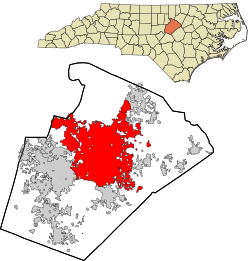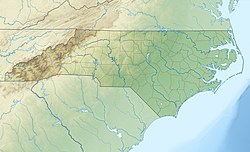Raleigh, North Carolina
Raleigh (/ˈrɔːli/ RALL-lee[9]) is the capital city of North Carolina as well as the county seat of Wake County.It is the second most populated city in North Carolina, after Charlotte. Raleigh is known as the "City of Oaks" for its many oak trees.[10] The area is also nicknamed "The Triangle".
Raleigh | |
|---|---|
 Clockwise from top left: NC State bell tower, Confederate Monument at the North Carolina State Capitol (now removed), houses in Boylan Heights, houses in Historic Oakwood, statue of Sir Walter Raleigh, skyline of the downtown, Fayetteville Street, and the warehouse district | |
| Nickname(s): | |
 Location in Wake County and the state of North Carolina | |
| Coordinates: 35°51′15″N 78°45′43″W / 35.85417°N 78.76194°W | |
| Country | United States |
| State | North Carolina |
| Counties | Wake, Durham |
| Chartered | December 31, 1794 |
| Named for | Sir Walter Raleigh |
| Government | |
| • Type | Council–manager |
| • Body | Raleigh City Council |
| • Mayor | Mary-Ann Baldwin (D) |
| Area | |
| • Total | 149.6 sq mi (387.5 km2) |
| • Land | 148.5 sq mi (384.7 km2) |
| • Water | 1.1 sq mi (2.8 km2) 0.72% |
| Elevation | 331 ft (101 m) |
| Population | |
| • Total | 467,665 |
| • Rank | 41st in the United States 2nd in North Carolina |
| • Density | 3,148.3/sq mi (1,215.6/km2) |
| • Urban | 1,106,646 (US: 43rd) |
| • Urban density | 1,994.6/sq mi (770.1/km2) |
| • Metro | 1,413,982 (US: 42nd) |
| Demonym | Raleighite |
| Time zone | UTC–05:00 (EST) |
| • Summer (DST) | UTC–04:00 (EDT) |
| ZIP Codes | 276XX |
| Area code(s) | 919, 984 |
| FIPS code | 37-55000[8] |
| GNIS feature ID | 2404590[5] |
| Major airport | Raleigh–Durham International Airport |
| Website | raleighnc |
Raleigh is part of the Research Triangle area, which includes Durham and Chapel Hill. The "Triangle" nickname began after the 1959 plan and construction of the Research Triangle Park, in Durham and Wake Counties. It is in the middle of the three cities and their universities.
The Research Triangle area makes up the U.S. Census Bureau's Raleigh-Durham-Chapel Hill Combined Statistical Area (CSA). It had an estimated population of 2,242,324 in 2020.[11]
History
changeRaleigh was made in 1770. In 1788, it became North Carolina's state capital. The first state fair happened in 1853 and has continued to happen every year. Raleigh was not hurt by the Civil War. It did not grow much after the Civil War.
In the early 1900s, Raleigh had streetcars, but they got rid of them later. Raleigh got its first TV station in 1956. In 1959, the Research Triangle Park was built. This caused people to move to the area for the jobs. In the late 1900s, Interstate 40 and Interstate 440 (freeways)were built, helping traffic. Since the late 1900s, Raleigh has grown quickly.
November 28, 1988 tornado
changeOn November 28, 1988, Raleigh was hit by a F4 tornado. The tornado formed after a very warm late November day. A line of thunderstorms that was spotted over the Charlotte area during the afternoon hours hit Raleigh just after 1:00 a.m. ET, however the National Weather Service (NWS) issued no tornado or severe thunderstorm watches for the area. They believed the conditions had not support the right for a tornado. There were two fatalities in the city of Raleigh, and four in total.
2011 tornado
changeOn April 16, 2011, an EF3 tornado struck Raleigh, killing 24 people in North Carolina and four in Raleigh.
Geography
changeRaleigh is in north-central North Carolina. It is in a hilly area. According to the United States Census Bureau, the city has a size of 149.60 square miles (387.5 km2). 148.54 square miles (384.7 km2) is land and 1.07 square miles (2.8 km2) (0.72%) is water. The Neuse River goes through the northeastern part of the city.[12] Most of the city is in Wake County, but a small part of Raleigh is in Durham County.
Cityscape
changeRaleigh is divided into many areas, and each of them use a Raleigh address and a ZIP code that begins with the numbers 276.
Climate
changeRaleigh has a mild climate. The summers are hot, with an average high of about 90°F (32°C). The winters are cool, with an average high of about 50°F (10°C). It snows about twice a year with a total of six inches (15 centimeters). Raleigh also gets around 45 inches of rain.
Transportation
changeRaleigh has a lot of good transportation. Some freeways are Interstate 40, I-440, and I-540. Some highways are U.S. Route 1, 64, and 70, and N.C. highway 50. Raleigh also has a Amtrak station and a big airport.
References
change- ↑ Delongowski, Carly (January 21, 2021). "Why is Raleigh nicknamed the City of Oaks?". RAL Today. Retrieved November 26, 2022.
- ↑ Wells Shannon, Mary (August 26, 2022). "The Best Nicknames for Southern Cities". Southern Living. Retrieved November 26, 2022.
- ↑ "City Council: Raleigh's Governing Body". City of Raleigh. May 6, 2016. Archived from the original on May 6, 2016. Retrieved May 9, 2016.
- ↑ "ArcGIS REST Services Directory". United States Census Bureau. Retrieved September 20, 2022.
- ↑ 5.0 5.1 U.S. Geological Survey Geographic Names Information System: Raleigh, North Carolina
- ↑ "QuickFacts: Raleigh city, North Carolina". United States Census Bureau. Retrieved February 26, 2024.
- ↑ "2020 Population and Housing State Data". United States Census Bureau. Retrieved August 22, 2021.
- ↑ "U.S. Census website". United States Census Bureau. Retrieved January 31, 2008.
- ↑ Wells, John C. (2009). "Ralegh, Raleigh". Longman Pronunciation Dictionary. London: Pearson Longman. ISBN 9781405881180.
- ↑ "Population & Census Information". City of Raleigh. Archived from the original on 2009-07-21. Retrieved 2009-08-21.
- ↑ "Metropolitan and Micropolitan Statistical Areas Population Totals: 2020-2022". United States Census Bureau. February 24, 2022. Retrieved August 13, 2022.
- ↑ "TIGERweb/Places_CouSub_ConCity_SubMCD (MapServer)". tigerweb.geo.census.gov. Retrieved 2024-10-29.
Other websites
change- Official website of Raleigh, NC
- Raleigh Chamber of Commerce
- From Crossroads to Capitol: the Founding and Early History of Raleigh, N.C. Archived 2011-11-17 at the Wayback Machine




